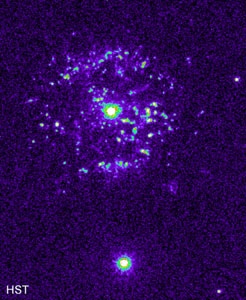nova
astronomy
plural Novas, or Novae,
 any of a class of exploding stars whose luminosity temporarily increases from several thousand to as much as 100,000 times its normal level. A nova reaches maximum luminosity within hours after its outburst and may shine intensely for several days or occasionally for a few weeks, after which it slowly returns to its former level of luminosity. Stars that become novas are nearly always too faint before eruption to be seen with the unaided eye. Their sudden increase in luminosity, however, is sometimes great enough to make them readily visible in the nighttime sky. To observers, such objects may appear to be new stars; hence the name nova from the Latin word for “new.”
any of a class of exploding stars whose luminosity temporarily increases from several thousand to as much as 100,000 times its normal level. A nova reaches maximum luminosity within hours after its outburst and may shine intensely for several days or occasionally for a few weeks, after which it slowly returns to its former level of luminosity. Stars that become novas are nearly always too faint before eruption to be seen with the unaided eye. Their sudden increase in luminosity, however, is sometimes great enough to make them readily visible in the nighttime sky. To observers, such objects may appear to be new stars; hence the name nova from the Latin word for “new.”Most novas are thought to occur in double-star systems in which members revolve closely around each other. Both members of such a system, commonly called a close binary star, are aged: one is a red giant and the other a white dwarf (white dwarf star). In certain cases, the red giant expands into the gravitational domain of its companion. The gravitational field of the white dwarf is so strong that hydrogen-rich matter from the outer atmosphere of the red giant is pulled onto the smaller star. When a sizable quantity of this material accumulates on the surface of the white dwarf, a nuclear explosion occurs there, causing the ejection of hot surface gases on the order of 1⁄10,000 the amount of material in the Sun. According to the prevailing theory, the white dwarf settles down after the explosion; however, the flow of hydrogen-rich material resumes immediately, and the whole process that produced the outburst repeats itself, resulting in another explosion about 1,000 to 10,000 years later. Recent research, however, suggests that such outbursts may recur at much longer intervals—every 100,000 years or so. It is explained that a nova eruption separates the members of the binary system, interrupting the transfer of matter until the two stars move close together again after a considerable length of time. See also supernova.
- Eiermann, Egon
- Eifel
- Eifelian Stage
- Eiffel, Gustave
- Eiffel Tower
- Eigen, Manfred
- eigenvalue
- eight ball
- Eight Eccentrics of Yangzhou
- eighteen schools
- Eightfold Path
- Eightfold Way
- Eight, Group of
- Eighth Route Army
- Eight Masters of Nanjing
- Eight Saints, War of the
- Eight, The
- Eighty Mile Beach
- Eighty Years' War
- Eijkman, Christiaan
- Eileen Collins
- Eileen Farrell
- Eileithyia
- Eilhardt Mitscherlich
- Eilhart Von Oberg